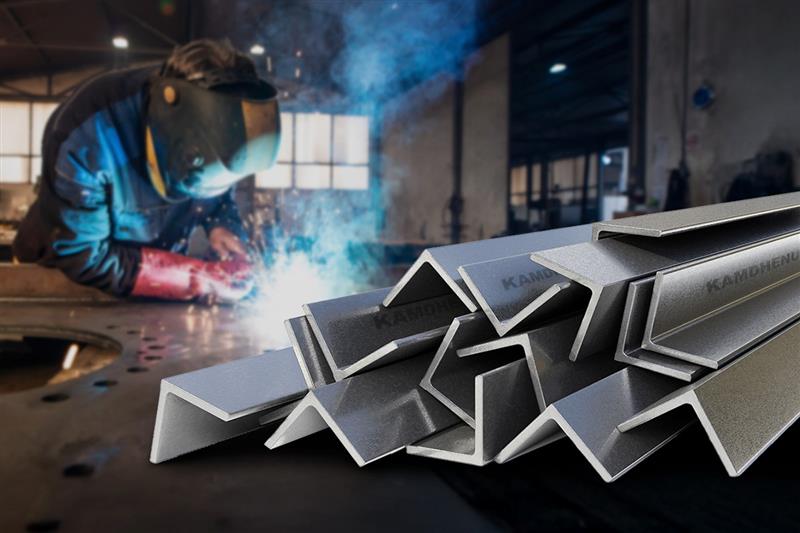If you’ve ever walked a construction site, whether it was your first home in the early ’90s or a fabrication yard last month, you know this: some materials may be hidden in the background, but their importance is front and centre.
MS Angle, or Mild Steel Angle, is one of those unsung heroes. It’s not as flashy as TMT bars or as techy as pre-engineered building components, but ask any seasoned contractor, and they’ll say: “Ek acha angle structure ka aadhaar hota hai.” Because without these reliable, L-shaped supports, the backbone of many of our buildings, gates, railings, and even bridges would just wobble.
So, let’s dive into why MS Angle remains a top choice for fabrication and infrastructure work in India, especially in an era where both strength and simplicity matter.
What Is MS Angle and Why Does It Matter?
An MS Angle is a steel product shaped like an “L”, with two legs typically at 90 degrees. It’s rolled from mild steel, which is a low-carbon variant known for its excellent weldability, malleability, and decent tensile strength. Depending on the dimensions and application, angles can be equal (both legs the same size) or unequal (one leg longer than the other).
But don’t let its simple geometry fool you, MS Angle plays a crucial role in:
- Structural framing
- Machinery support
- Towers and transmission lines
- Bridges, sheds, and trusses
- Grills, gates, fencing, and brackets
In short, if your project involves strength, alignment, or load transfer, it probably involves MS Angle too.
1. Time-Tested Strength with Practical Flexibility
Mild steel doesn’t try to be a superhero. It just shows up, performs, and endures.
An MS Angle combines rigidity with flexibility, allowing it to support substantial loads while being easy to weld, cut, or bend as needed. This makes it ideal for both static and dynamic structures, whether it’s the frame of a bus stop shelter or a roof truss for a godown.
It also doesn’t crack under stress or shatter like high-carbon alternatives. Think of it as the dependable uncle of your project team, steady, versatile, and always present when things need to be held together.
2. BIS-Backed Quality Assurance
For those who still remember the time when steel came in varying weights and sizes, measured more by guesswork than gauges, you’ll appreciate this shift: modern MS Angles are now governed by IS 2062 standards, which specify chemical composition, mechanical properties, and dimensional tolerances.
According to IS 2062:2011 (E250 and above), MS Angles used for structural applications must meet:
- Minimum yield strength of 250 MPa or more
- Controlled levels of carbon (0.23% max for E250)
- Required elongation percentages for ductility
- Sulphur and phosphorus limits to reduce brittleness
So when you see BIS certification on an MS Angle, you’re not just getting steel, you’re getting consistency and compliance.
3. Perfect Companion to TMT Bars in Construction
Ask any builder, TMT bars and MS Angles often go hand in hand. While TMT bars reinforce concrete in columns, beams, and slabs, MS Angles provide the support for non-concrete applications like roof framing, partitions, gates, and lintels.
Let’s say you’re building a shed in a high-humidity zone like Kolkata. You’d use TMT for the foundation and core structure, but MS Angles would frame the roof and support purlins. Why? Because they can handle both tension and compression with ease, and they’re easier to modify on-site.
TMT gives you strength in concrete. MS Angle? That gives you shape, support, and flexibility beyond the concrete.
4. Ideal for Indian Site Realities
Construction in India is rarely textbook. Sites are cramped, timelines are tight, and labour conditions vary. In such scenarios, materials that adapt without fuss are prized, and MS Angles shine here.
- Easy transport: Even longer angles can be moved without the need for cranes
- On-site modifiability: Need to drill, weld, or bend? No problem.
- Minimal prep required: No special tools or high-tech handling
This makes them especially popular for Tier-2 and Tier-3 city projects, where every minute saved on the job site matters.
5. Cost-Efficiency Without Compromising Quality
While materials like stainless steel or aluminium offer aesthetic benefits, mild steel angles remain cost-effective, a major advantage when working with tight budgets or scale-heavy projects like:
- Telecom towers
- Warehouse racks
- Agricultural equipment
- Bus shelters or skywalks
Because MS Angle is less expensive per kg than many alternatives and requires less maintenance over time, it becomes a natural choice for both private developers and public infrastructure projects.
6. Proven Across Infrastructure & Fabrication Use Cases
Still unsure where MS Angles make a difference? Here’s a quick roundup:
| Use Case | Why MS Angle Works |
| Telecom/Transmission Towers | Load-bearing, easy to assemble |
| Industrial Racks & Frames | Custom sizing, good weldability |
| Roof Trusses | Ideal for tension and compression |
| Railings and Gates | Strong, easy to fabricate and paint |
| Vehicle Chassis/Support Frames | High fatigue resistance |
Many of these applications also rely on galvanised MS Angles, which offer enhanced corrosion protection, especially in coastal or rain-heavy areas.
7. Steel That Aligns with Indian Sentiment
In Indian homes, construction isn’t just technical, it’s emotional. The roof over your head isn’t just a roof, it’s your children’s first school, your parents’ retirement shelter, your lifelong dream.
And when elders say, “Banaye toh aisa banaye ki agle 30 saal tak sochna na pade”, they mean it.
MS Angle helps turn that philosophy into practice. It’s reliable, repairable, recyclable, and, when chosen with proper standards, built to last generations.
Final Thoughts: Let the Angles Do the Heavy Lifting
Choosing steel products isn’t just about tensile strength or price per ton. It’s about what that steel enables. MS Angles offer a rare combination of performance, flexibility, and affordability, making them indispensable for everything from residential gates to industrial sheds.
So next time you’re planning a fabrication job or sketching out structural reinforcements, don’t just focus on your TMT grades or cement mix. Take a moment to consider the angles, those L-shaped lifelines that keep India’s infrastructure standing tall.
Because good construction isn’t just about what’s visible, it’s about what holds everything up, quietly and reliably.







Leave a Reply